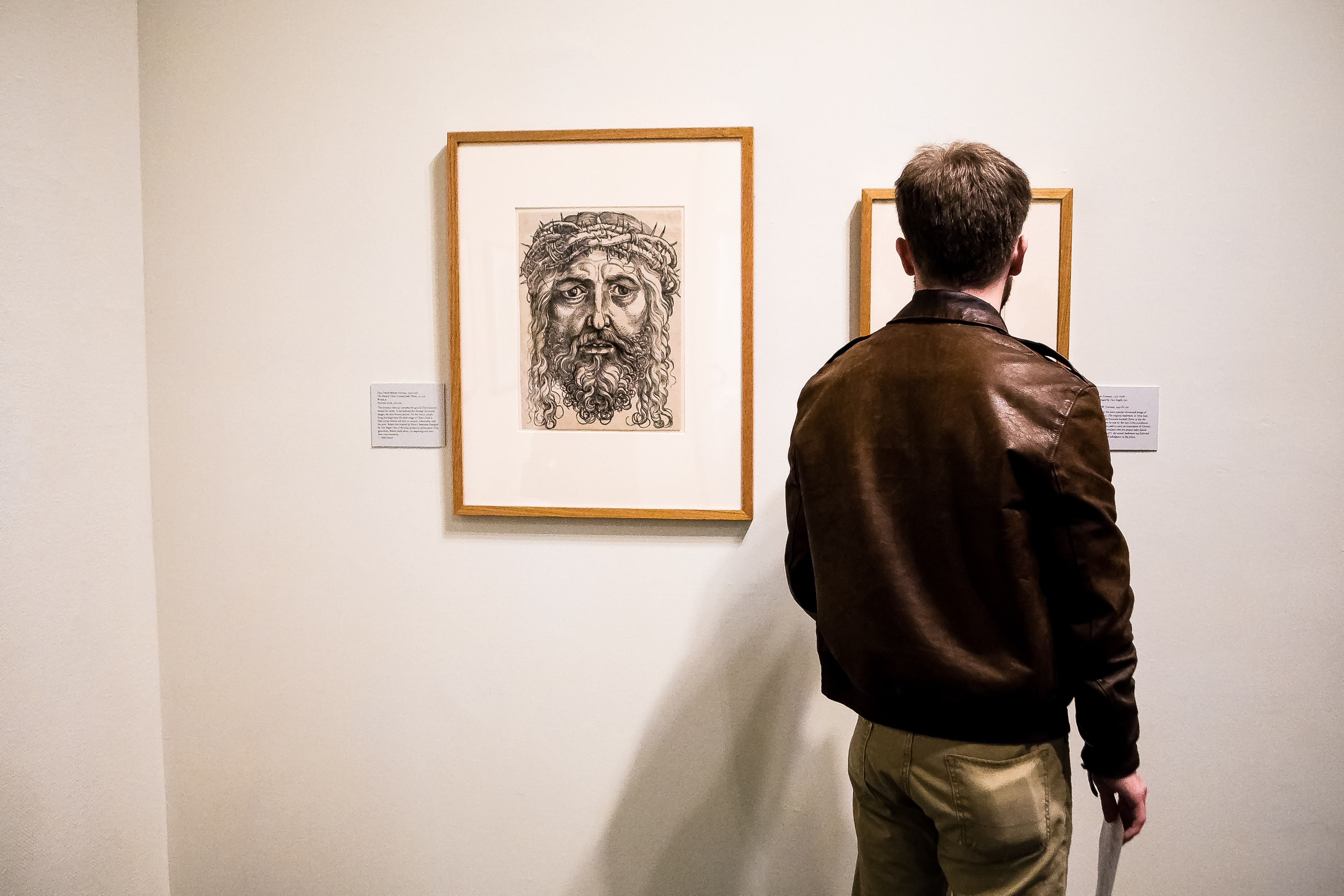
Jonas Powell, Photo Editor
Last Friday, I attended the opening of “Passion and Power: German Prints in the Age of Dürer” at the Davison Art Center (DAC). The titular “passion” refers to themes of religious fervor, torment, love and sexuality present in these works, while “power” refers to the fact that powerful men such as Martin Luther and Holy Roman Emperor Maximilian I utilized the prints to create and spread their influence. This exhibition presented more than 80 prints and rare books from the permanent collection of the Davison Art Center and Olin Library. This includes 33 prints by Albrecht Dürer, as well as prints by his contemporaries Lucas Cranach the Elder and the “Little Masters”: Hans Sebald Beham and Georg Pencz. The DAC collection is so huge, in fact, that curators chose from 400 prints from this era to present at this exhibit.
The exhibition was curated by 13 students as part of a museum studies seminar taught by Davison Art Center Curator Clare Rogan. Students chose prints that presented a cross-section of the period and arranged the representative prints thematically. The themes dealt with a fascination with the Apocalypse, religious suffering and ornamentation, printmaking, the rise of the Reformation, the use of prints as propaganda for Holy Roman Emperor Maximilian I, depictions of women, and the new interest in scientific observation and the natural world. Two to three students worked on each theme.
Sharifa Lookman ’17 thoroughly enjoyed the opportunities the course afforded her.
“It was a great introduction to museum work and it was amazing to see these prints every week,” she said.
Lookman also expressed enthusiasm at having been given the opportunity to go to the Yale conservation labs.
Rogan teaches this course every three or so years. In the past, students have created exhibitions on 18th-century prints, Honoré Daumier and French Lithography, and American photography in the 20th century. Her favorite part of teaching the course is when students interpret questions personally and follow their own ideas. She further added that this is a class about doing things and at the end of the day, you have to make a decision, and choose works of art that make sense.
The works of art that they chose are as impressive as they are diverse. Dürer, often referred to as the “Leonardo da Vinci of the North,” was one of the greatest and most influential German artists of the Renaissance. He visited Italy twice, from 1494 to 1495, and again from 1505 to 1507, where he absorbed the great works of his Italian contemporaries and bore witness to the classical heritage and theoretical writings of the region. Having brought back his knowledge of Italian art upon returning to the German art scene, Dürer succeeded in connecting the two artistic realms.
One result of this fusion is his print of Adam and Eve. Many historians believe that he copied the figures from Italian sculptures. Along with Adam and Eve, the print depicts eight animals: a parrot, an elk, an ox, a cat, a rabbit, a mouse, a serpent, and a tiny mountain goat perched on the top of the mountain. Each animal symbolizes some aspect of human nature, both physical and moral. The Bull, for example, stands for the phlegmatic humor, the rabbit the sanguine humor, the elk the melancholic humor, the cat the choleric humor, the mouse male weakness, the mountain goat lust and damnation, the parrot salvation, and the serpent evil.
Dürer revolutionized printmaking, elevating it to an independent art form. He used several different printing techniques, including etchings, woodcuts, and engravings. Surprisingly, Dürer only made six etchings in his life, two of which are on exhibit at the Davison Art Center, a testament to the impressiveness of the Center’s collection. Through his work, he expanded the tonal and dramatic range of prints and provided them with a new conceptual foundation.
Dürer was the official court artist to two Holy Roman Emperors, Maximilian I and his successor Charles V. A large commemorative woodcut portrait of Maximilian I, designed by Dürer, depicts Maximilian as a strong, dominating figure, thus reinforcing his imperial power. Impressions of this print would have been sent around his extensive empire after his death in 1519.
An especially fascinating wall was one dedicated to depictions of women. The prints displayed here brought insight into how men of the German Renaissance viewed their sexual counterparts. Dürer’s depictions of the opposite sex are ambivalent and, at times, contradictory. On the one hand, he represented the Virgin Mary and her devotion to God, portraying her as a mother whose unconditional love for her child illustrates the ideal woman. She is a role model for her gender. On the other hand, Dürer’s secular prints of women associated them with danger, rendering them sexual and harmful. There are absolutely no prints that contain moderate depictions of women; Dürer and his contemporaries appear to have represented the female gender exclusively in these two extreme contexts.
The prints currently exhibited, however, represent only a small portion of this collection; the DAC’s full collection consists chiefly of some 24,000 works of art on paper, mostly original prints and photographs, with smaller numbers of works in other media. To see the works firsthand, you can schedule an appointment with Rogan. They have all sorts of works of art, from photos by Cindy Sherman to prints by Rembrandt. “Passion and Power: German Prints in the Age of Dürer” closes on March 3.
Comments are closed